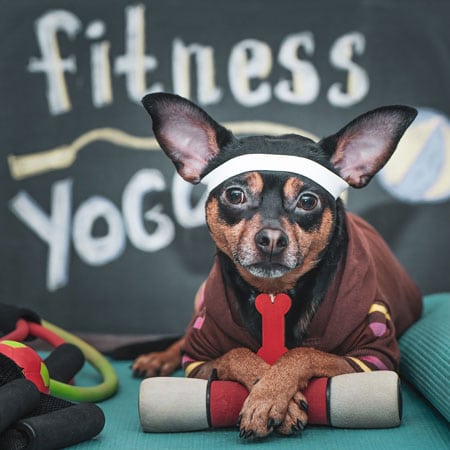Do you feel guilty that your pet doesn’t get enough time with you? It’s a trap that happens to most of us, but one that can be easily remedied. Here are some guidelines for enriching your pet’s life and health through exercise.
Why Exercising Your Dog Makes Sense
Big or small, young or old, dogs need to exercise daily. While some breeds have special needs that have to be taken into account, and dogs do slow down as they age, they still need to take part in some form of daily physical activity. Without activity, your dog will become bored, frustrated and unhealthy. Exercise tones the muscles, helps the body and metabolic system to function properly, and engages the mind. Anyone who has had a dog that suffers from lack of physical activity and mental stimulation will tell you that they will often turn to destructive behaviors — behaviors that magically disappear once the dog is getting out everyday.

Physically, dogs will also become obese if they are not allowed to burn off the calories they take in during the day. This is especially true if they are being given a lot of treats in compensation for lack of attention.
How Much is Too Much Exercise?
Though exercise needs are based on a dog’s age, breed, size and overall health, your dog should spend between 30 minutes to two hours on an activity every day. Breeds in the hunting, working, or herding groups (e.g., Labrador retrievers, hounds, collies and shepherds) will need the most exercise. If your dog is in one of these groups and is in good health, she should be getting at least 30 minutes of rigorous exercise along with her 1-2 hours of daily activity.
Requirements aren’t as easily established for every other dog. Because most dogs are of mixed heritage, their needs will be different depending on the breed they are descended from. If your dog is a short nosed breed, like a Bulldog, for example, he will not need a lot of daily exercise. A casual walk around the neighborhood will be sufficient. Pay attention to your dog’s signals. If he is restless or pacing, he is probably itching to get out for a nice long walk. If, on the other hand, your dog is content to just lie around, there may not be such a great need for exercise. A short walk will be enough to keep everything in order.
Dogs that are less active or older may have conditions that are slowing them down. Whether it is because of too much weight, achy joints and muscles, or they just like to mellow out most of the time, they still need some activity to keep the body working as it should.
Even dogs that are handicapped, like those that use specially equipped wheelchairs or carts, often enjoy a walk through the neighborhood. Some can even continue to take part in water activities!
If you have any concerns about whether your dog can handle a long walk or whether you should implement an exercise plan for her, talk to your veterinarian. You don’t want to pressure your dog into doing things that are too strenuous or you could end up with bigger problems. Start slow if your dog has not been accustomed to being physically active, and observe her response, adding more activities or more mileage as she gets stronger. Your dog should be happily tired, not exhausted, when you are done exercising her for the day.
Tips Before Beginning an Exercise Program
Before you begin an exercise program with your dog, be sure to visit your veterinarian for a health check. Your doctor can recommend an exercises plan that is appropriate for your dog’s age, breed and condition. Plan to start out slowly and work your way up to longer walking or playing routines as they seem suitable. Additionally, don’t forget to allow for a warm-up period and cool-down time at the end of your session. A leisurely walk to the park or around the block before exercise should be enough to warm the muscles and prepare them for a serious game of catch.
And don’t forget that mental stimulation is just as important as physical exercise. Don’t be afraid of taking new running paths with your dog, going to different dog parks in your area, or introducing new toys and games to your routine. Most importantly, spend time exercising daily, not just on the weekends, even if only for a short time. At the very least, dogs and humans alike can benefit from 30 minutes of physical activity each day. Start simple, without putting pressure on yourself or your dog, and you will find that you are both looking forward to this happy time of the day — every day.
Reference: PetMD
 Skip to content
Skip to content
